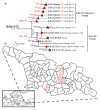Phylogeography of Francisella tularensis subspecies holarctica from the country of Georgia
- PMID: 21682874
- PMCID: PMC3224097
- DOI: 10.1186/1471-2180-11-139
Phylogeography of Francisella tularensis subspecies holarctica from the country of Georgia
Abstract
Background: Francisella tularensis, the causative agent of tularemia, displays subspecies-specific differences in virulence, geographic distribution, and genetic diversity. F. tularensis subsp. holarctica is widely distributed throughout the Northern Hemisphere. In Europe, F. tularensis subsp. holarctica isolates have largely been assigned to two phylogenetic groups that have specific geographic distributions. Most isolates from Western Europe are assigned to the B.Br.FTNF002-00 group, whereas most isolates from Eastern Europe are assigned to numerous lineages within the B.Br.013 group. The eastern geographic extent of the B.Br.013 group is currently unknown due to a lack of phylogenetic knowledge about populations at the European/Asian juncture and in Asia. In this study, we address this knowledge gap by describing the phylogenetic structure of F. tularensis subsp. holarctica isolates from the country of Georgia, and by placing these isolates into a global phylogeographic context.
Results: We identified a new genetic lineage of F. tularensis subsp. holarctica from Georgia that belongs to the B.Br.013 group. This new lineage is genetically and geographically distinct from lineages previously described from the B.Br.013 group from Central-Eastern Europe. Importantly, this new lineage is basal within the B.Br.013 group, indicating the Georgian lineage diverged before the diversification of the other known B.Br.013 lineages. Although two isolates from the Georgian lineage were collected nearby in the Ukrainian region of Crimea, all other global isolates assigned to this lineage were collected in Georgia. This restricted geographic distribution, as well as the high levels of genetic diversity within the lineage, is consistent with a relatively older origin and localized differentiation.
Conclusions: We identified a new lineage of F. tularensis subsp. holarctica from Georgia that appears to have an older origin than any other diversified lineages previously described from the B.Br.013 group. This finding suggests that additional phylogenetic studies of F. tularensis subsp. holarctica populations in Eastern Europe and Asia have the potential to yield important new insights into the evolutionary history and phylogeography of this broadly dispersed F. tularensis subspecies.
Figures


Similar articles
-
Phylogenetic Lineages of Francisella tularensis in Animals.Front Cell Infect Microbiol. 2018 Jul 31;8:258. doi: 10.3389/fcimb.2018.00258. eCollection 2018. Front Cell Infect Microbiol. 2018. PMID: 30109216 Free PMC article. Review.
-
Phylogeography of Francisella tularensis: global expansion of a highly fit clone.J Bacteriol. 2009 Apr;191(8):2474-84. doi: 10.1128/JB.01786-08. Epub 2009 Feb 27. J Bacteriol. 2009. PMID: 19251856 Free PMC article.
-
Phylogeography of Francisella tularensis from Tibet, China: Evidence for an asian origin and radiation of holarctica-type Tularemia.Ticks Tick Borne Dis. 2016 Jul;7(5):865-868. doi: 10.1016/j.ttbdis.2016.04.001. Epub 2016 Apr 11. Ticks Tick Borne Dis. 2016. PMID: 27150591
-
Genetic Diversity and Spatial Segregation of Francisella tularensis Subspecies holarctica in Germany.Front Cell Infect Microbiol. 2019 Nov 6;9:376. doi: 10.3389/fcimb.2019.00376. eCollection 2019. Front Cell Infect Microbiol. 2019. PMID: 31781515 Free PMC article.
-
Genotyping of Francisella tularensis, the causative agent of tularemia.J AOAC Int. 2010 Nov-Dec;93(6):1930-43. J AOAC Int. 2010. PMID: 21313823 Review.
Cited by
-
Epidemiologic and Epizootic Data of Tularemia in the Past and in the Recent History in Croatia.Microorganisms. 2020 May 12;8(5):721. doi: 10.3390/microorganisms8050721. Microorganisms. 2020. PMID: 32408663 Free PMC article. Review.
-
Genetic Traces of the Francisella tularensis Colonization of Spain, 1998-2020.Microorganisms. 2020 Nov 14;8(11):1784. doi: 10.3390/microorganisms8111784. Microorganisms. 2020. PMID: 33202547 Free PMC article.
-
Phylogeographic Distribution of Human and Hare Francisella Tularensis Subsp. Holarctica Strains in the Netherlands and Its Pathology in European Brown Hares (Lepus Europaeus).Front Cell Infect Microbiol. 2019 Feb 11;9:11. doi: 10.3389/fcimb.2019.00011. eCollection 2019. Front Cell Infect Microbiol. 2019. PMID: 30805312 Free PMC article.
-
Francisella tularensis Susceptibility to Antibiotics: A Comprehensive Review of the Data Obtained In vitro and in Animal Models.Front Cell Infect Microbiol. 2017 Apr 11;7:122. doi: 10.3389/fcimb.2017.00122. eCollection 2017. Front Cell Infect Microbiol. 2017. PMID: 28443249 Free PMC article. Review.
-
Phylogenetic Lineages of Francisella tularensis in Animals.Front Cell Infect Microbiol. 2018 Jul 31;8:258. doi: 10.3389/fcimb.2018.00258. eCollection 2018. Front Cell Infect Microbiol. 2018. PMID: 30109216 Free PMC article. Review.
References
-
- Huber BE, Escudero R, Busse HJ, Seibold E, Scholz HC, Anda P, Kampfer P, Splettstoesser WD. Description of Francisella hispaniensis sp. nov., isolated from human blood, reclassification of Francisella novicida (Larson et al. 1955) Olsufiev et al. 1959 as Francisella tularensis subsp. novicida comb. nov., and emended description of the genus Francisella. Int J Syst Evol Microbiol. 2009. - PubMed
-
- Johansson A, Celli J, Conlan W, Elkins KL, Forsman M, Keim PS, Larsson P, Manoil C, Nano FE, Petersen JM, Sjostedt A. Objections to the transfer of Francisella novicida to the subspecies rank of Francisella tularensis. Int J Syst Evol Microbiol. 2010;60:1717–1718. doi: 10.1099/ijs.0.022830-0. author reply 1718-1720. - DOI - PMC - PubMed
Publication types
MeSH terms
Substances
LinkOut - more resources
Full Text Sources
Miscellaneous

